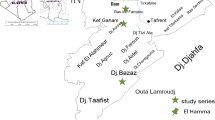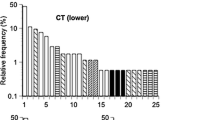Summary
This paper reports part of a study to determine why damaging outbreaks of the pine beauty moth, Panolis flammea (D & S) (Lepidoptera: Noctuidae), in Scotland are frequent on lodgepole pine but do not occur on Scots pine, and why outbreaks on lodgepole pine are mainly confined to trees growing in deep unflushed peat. The elongation of shoots and the growth of needles of Scots pine occurred later in the season than did those of lodgepole pine. The foliage of Scots pine generally had a higher level of nitrogen, and consistently had a higher level of phosporus, but had a consistently lower level of tannins than that of lodgepole pine during the period when the larvae were feeding each year. The nitrogen content of the foliage of lodgepole pine growing in an iron pan soil was generally higher than that of lodgepole pine growing in deep peat during the same period but there were no general differences in the phosphorus or tannin contents of lodgepole pine in the 2 soil types. These findings suggest that Scots pine is a more suitable host plant than lodgepole pine and that the foliage of lodgepole pine growing in deep peat is not more suitable than lodgepole pine growing in an iron pan soil. On the basis of the chemical analyses used in this study, it is concluded that the abundance of pine beauty moth in Scotland is not strongly influenced by the nutritional suitability of its host plants.
Similar content being viewed by others
References
Allen SJ, Grimshaw M, Parkinson JR, Quarmby C (1974) Chemical analysis of ecological methods. Blackwell, Oxford
Barnett DW (1987) Pine beauty moth outbreaks: associations with soil type, host nutrient status and tree vigour. In Leather SR, Stoakley JT, Evans HF (eds) Population Biology and Control of the Pine Beauty Moth Forestry Commission, Edinburgh, pp 14–20
Bernays EA (1981) Plant tannins and insect herbivores: an appraisal. Ecol Entomol 6:353–360
Bevan D (1987) Forest Insects. Forestry Commission, Edinburgh
Faeth SH (1985) Quantitative defense theory patterns of feeding by oak insects. Oecologia 68:34–40
Feeny P (1970) Seasonal changes in oak leaf tannins and nutrients as a cause of spring feeding by winter moth caterpillars. Ecology 51:565–581
Fogal WH (1974) Nutritive value of pine foliage for some Diprionid sawflies. Proc Entomol Soc Ontario 105:101–118
Hanski I, Otronen M (1985) Food quality induced variance in larval performance: comparison between rare and common pine feeding sawflies (Diprionidae). Oikos 44:165–174
Hanski I, Parviainen P (1985) Cocoon predation by small mammals, and pine sawfly population dynamics. Oikos 45:125–136
Haukioja E, Niemela P, Siren S (1985) Foliage phenols and nitrogen in relation to growth, insect damage, and ability to recover after defoliation, in the mountain birch Betula pubescens spp tortuosa. Oecologia 65:214–222
Larsson S, Tenow O (1979) Utilization of dry matter and bioelements in larvae of Neodiprion sertifer Geoffr. (Hym. Diprionidae) feeding on Scots pine (Pinus sylvestris L.). Oecologia 43:157–172
Larsson S, Tenow O (1984) Areal distribution of a Neodiprion sertifer (Hym. Diprionidae) outbreak on Scots pine related to stand condition. Holarct Ecol 7:81–90
Leather SR, Barbour DA (1987) Associations between soil type, lodgepole pine (Pinus contorta Douglas) provenance, and the abundance of the pine beauty moth, Panolis flammea (D & S). J Appl Ecol 24:945–951
Mattson WJ, Addy ND (1975) Phytophagous insects as regulators of forest primary production. Science 190:515–522
Mattson WJ, Haack RA (1987) The role of drought in outbreaks of plant-eating insects. BioScience 37:110–118
Mattson WJ, Scriber JM (1986) Nutritional ecology of insect folivores of woody plants: nitrogen, water, fibre and mineral considerations. In: Slansky F Jr, Rodrigues JG (eds) The Nutritional Ecology of Insects, Mites, and Spiders. John Wiley, New York pp 105–146
McCullough DG, Wagner MR (1987) Influence of watering and trenching ponderosa pine on a pine sawfly. Oecologia 71:382–387
McNeill S, Southwood TRE (1978) The role of nitrogen in the development of insect/plant relationships. In: Harborne J (ed) Biochemical Aspects of Plant and Animal Coevolution. Academic Press, London pp 77–98
Newberry DM, Hill MG, Waterman PG (1983) Host-tree susceptibility to the coccid Icerya seychellarum West. (Margarodidae: Homoptera) on Aldabra Atoll: the role of leaf morphology, chemistry and phenology. Oecologia 60:333–339
Niemela P, Rousi M, Saarenmaa H (1987) Topographical delimination of Neodiprion sertifer (Hym. Diprionidae) outbreak on Scots pine in relation to needle quality. J Appl Entomol 103:84–91
Rhoades DF (1979) Evolution of plant defense against herbivores. In: Rosenthal GA, Janzen DH (eds), Herbivores: Their Interactions with Secondary Plant Metabolites. Academic Press, New York pp 3–54
Rhoades DF (1983) Herbivore Population Dynamics and Plant Chemistry. In: Denno RF, McClure MS (eds) Variable Plants and Herbivores in Natural and Managed Systems. Academic Press, New York pp 155–220
Rhoades DF, Cates RG (1976) Toward a general theory of plant antiherbivore chemistry. Rec Adv Phytochem 10:168–213
Stoakley JT (1977) A severe outbreak of the pine beauty moth on lodgepole pine in Sutherland. Scot For 31:113–125
Swain T (1979) Tannins and Lignins. In: Rosenthal GA, Janzen DH (eds) Herbivores: Their Interaction with Secondary Plant Metabolites. Academic Press, New York pp 657–682
Taper ML, Case TJ (1987) Interactions between oak tannins and parasite community structure: unexpected benefits of tannins to cynipid gall-wasps. Oecologia 71:254–261
Wagner MR (1986) Influence of moisture stress and induced resistance in ponderosa Dougl. ex. Laws, on the pine sawfly, Neodiprion autumnalis Smith. For Ecol Manag 15:43–53
Watt AD (1986) The performance of the pine beauty moth on water-stressed lodgepole pine plants: a laboratory experiment. Oecologia 70:578–579
Watt AD (1987a) The effect of shoot growth stage of Pinus contorta and Pinus sylvestris on the growth and survival of Panolis flammea larvae. Oecologia 72:429–433
Watt AD (1987b) Pine beauty moth outbreaks: the influence of host species, plant phenology, soil type, plant stress and natural enemies. In: Leather SR, Stoakley JT, Evans HF (eds) Population Biology and Control of Pine Beauty Moth Forestry Commission, Edinburgh, pp 21–25
Watt AD (1988) Effects of stress-induced changes in plant quality and host-plant species on the population dynamics of the pine beauty moth in Scotland: partial life tables of natural and manipulated populations. J Appl Ecol 25:209–221
Watt AD, Leather SR (1988a) The impact and ecology of the pine beauty moth in upland pine forests. In: Usher MB, Thompson DBA (eds) Ecological Change in the Uplands (in press)
Watt AD, Leather SR (1988b) The pine beauty moth in Scottish lodgepole pine plantations. In: Berryman AA (ed) Insects in Forest Ecosystems: Enquiries into the Causes of Outbreaks. (in press)
Watt AD, Leather SR (1988c) The distribution of eggs laid by the pine beauty moth Panolis flammea, on lodgepole pine. J Appl Entomol 106:108–110
White TCR (1969) An index to measure weather-induced stress of trees associated with outbreaks of psyllids in Australia. Ecology 50:905–909
White TCR (1974) A hypothesis to explain outbreaks of looper caterpillars, with special reference to populations of Selidosema suavis in a plantation of Pinus radiata in New Zealand. Oecologia 16:279–301
White TCR (1976) Weather, food and plagues of locusts. Oecologia 22:119–134
White TCR (1984) The abundance of invertebrate herbivores in relation to the availability of nitrogen in stressed food plants. Oecologia 63:90–105
Zucker WV (1983) Tannins: does structure determine function? An ecological perspective. Am Nat 121:335–365
Author information
Authors and Affiliations
Rights and permissions
About this article
Cite this article
Watt, A.D. The chemical composition of pine foliage in relation to the population dynamics of the pine beauty moth, Panolis flammea, in Scotland. Oecologia 78, 251–258 (1989). https://doi.org/10.1007/BF00377163
Received:
Issue Date:
DOI: https://doi.org/10.1007/BF00377163




